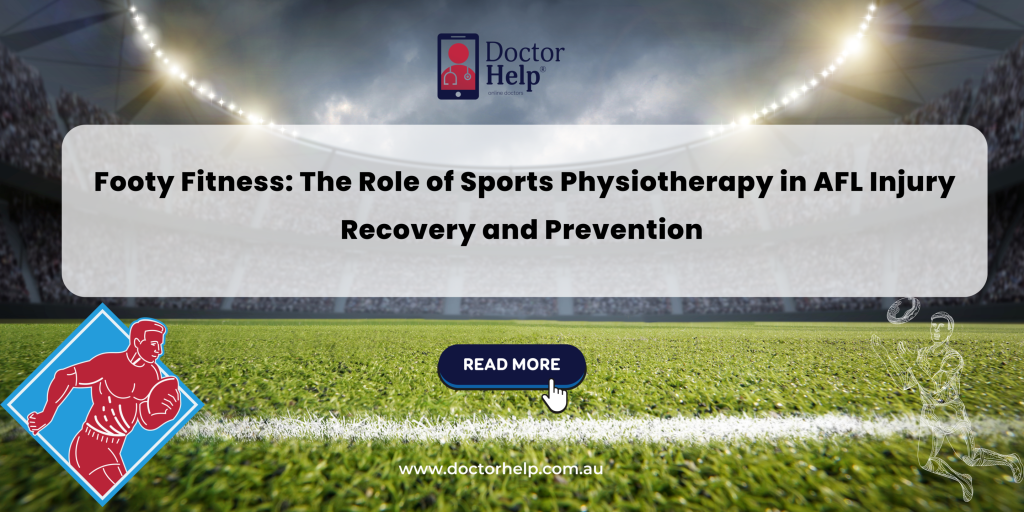Table of Contents
While injuries can’t be avoided entirely while playing, sports physiotherapy is essential in sports, especially after constantly playing in a league (eg; AFL). It’s important for injury recovery and prevention, to help athletes maintain form and fitness, reduce risk of injuries, and accelerate recovery.
Sports Physiotherapy And Significance
Sports physiotherapists help athletes of all levels, from amateurs to professionals. This technique offers tailored programs to maintain and improve physical health. It includes methods for injury prevention, treatment, and specific rehabilitation for athletes through physical exercises. This is a fundamental part of athlete training in sports such as rugby, football, etc, for building the form, preventing injury, and rehabilitation. This proactive approach in physiotherapy also helps athletes improve their performance and extend their sports careers by minimizing the risk of recurrent injuries.
Common Sports Injuries and Their Management
Sports injuries can range from minor sprains to severe ligament tears or fractures. The type and severity of injury often depend on the sport, the intensity, and the frequency of training.
As per the stats, Australian Rules Football has the highest rate of injuries nationwide.
Following are some of the most common types of injuries are common among footy Players.
- Hamstring injuries: Resulting in approximately 19.1 missed games per club, per season (2015).
- ACL injuries: Leading to around 16.7 missed games per club, per season.
- Shoulder sprains and dislocations: Causing an average of 11.5 missed games per club, per season.
- Leg and foot fractures: Resulting in about 8.6 missed games per club, per season.
- Ankle sprains and joint injuries: Leading to around 7.2 missed games per club, per season.
Sports Physiotherapy Techniques for Different Injuries
Manual Therapy:
This hands-on approach involves techniques like massage, joint mobilization, and manipulation to alleviate pain, improve mobility, and enhance muscle and joint function. In football players, physiotherapy helps reduce muscle tension, improve circulation, and facilitate healing in injured tissues. Techniques such as soft tissue massage or joint adjustments can accelerate recovery by restoring normal movement and alignment.
Therapeutic Exercises:
This type of sports physiotherapy is designed to improve strength, flexibility, and endurance in the affected area, promoting recovery and reducing the risk of re-injury. These include stretching, strengthening, balance, and functional exercises aimed at restoring full range of motion and muscle control. Incremental progression ensures athletes can return to their sport safely and stronger than before.
Ultrasound or Electrotherapy:
Ultrasound Therapy: Uses high-frequency sound waves to promote tissue healing and reduce inflammation. It stimulates deep tissues, revving repair and providing pain relief.
Electrotherapy: Involves the use of electrical currents (e.g., TENS or EMS) to relieve pain, reduce swelling, and stimulate muscle contractions to maintain strength during recovery.
Both methods are particularly useful for soft tissue injuries and post-surgery rehabilitation.
Personalized Rehabilitation Programs:
These programs are tailored specifically to an athlete’s needs and goals, focusing on their particular sport and injury. They incorporate a mix of therapies, exercises, and conditioning programs designed to return athletes to peak performance. The rehab plan evolves as the athlete progresses, ensuring a gradual, safe return to their sport and addressing any imbalances or weaknesses to prevent future injuries. These techniques work together to not only help athletes recover from injuries but also strengthen the affected areas, enhancing performance and reducing the risk of recurring issues.
Injury Prevention in Athletes
Injury prevention is an integral part of sports physiotherapy. A prophylactic approach not only helps keep footy players in adequate shape but also significantly reduces the risk of serious injuries. Injury prevention is crucial for a long and successful sports career. This includes strengthening programs, flexibility exercises, and education on proper training and rest techniques.
Preventive strategies include proper warm-up and cool-down exercises, flexibility and strength training, and techniques to improve balance and coordination. These strategies are personalized according to the individual needs of each athlete.
The Role of the Physiotherapy in Sports Recovery
Sports Physiotherapy plays a key role in the recovery from sports injuries.
Evaluation and Diagnosis
The first step in recovery is an accurate evaluation and diagnosis of the injury. The physiotherapist uses various diagnostic techniques to understand the extent of the injury and plan the most appropriate treatment.
Treatment Planning
Treatment planning includes a personalized rehabilitation program that may include specific exercises, manual therapy, and education on managing the injury. The goal is not only to recover from the injury but also to prevent future recurrences.
Innovative Treatments in Sports Physiotherapy
Sports physiotherapy is constantly evolving, incorporating innovative treatments that improve recovery outcomes.
Advanced Therapies and Their Effectiveness
Advanced therapies include laser therapy, cryotherapy, and electrostimulation techniques. These therapies can speed up the recovery process, reduce pain, and improve functionality.
Help Manage the Form of Athletes
An essential aspect of sports physiotherapy is providing athletes with practical advice they can incorporate into their daily routine to improve performance and prevent injuries.
Developing Self-Care Routines
Self-care routines include self-massage techniques, stretching, and specific exercises to keep the body in optimal condition. Proper nutrition and sufficient rest are also crucial for effective recovery.
Why is it Important to Consult with Physiotherapists?
As an athlete, regular consultations with a physiotherapist can help you stay on top of your game and avoid injuries, as they allow for ongoing progress monitoring, timely adjustments to training programs, and the early detection of minor issues before they escalate into serious injuries.
Recovering from sports injuries involves not only the physical aspects but also psychological ones. Addressing them is key to a complete and holistic recovery. Effective management of pain and fatigue through techniques like hot and cold therapy, massages, and pain management strategies supports the physical healing process. Also, get online physiotherapist referrals via telehealth with convenience via Doctor Help.
At the same time, physiotherapists also provide psychological support to help athletes manage the stress, frustration, and mental challenges of rehabilitation, ensuring they stay motivated and maintain a positive mindset. Integrating physiotherapy into regular training routines, rather than just in response to injury, is crucial for optimizing performance, preventing injuries, and maintaining overall physical and mental well-being in sports.
Tips for Incorporating Physiotherapy into Training
Incorporating sports physiotherapy into daily training can include specific preventive exercises, regular manual therapy sessions, and consultations with physiotherapists to evaluate and improve the sports techniques of footy players.
Collaboration between Coaches and Physiotherapists
Collaboration between coaches and physiotherapists is essential for developing a comprehensive training program that considers both performance and injury prevention.
Technology and Physiotherapy: A Futuristic Alliance
Technology is playing an increasingly important role in physiotherapy, offering new forms of treatment and analysis that benefit both physiotherapists and athletes.
Technological Tools in Physiotherapy
Technological tools in physiotherapy include biofeedback equipment, virtual reality for rehabilitation, and mobile applications for monitoring and analyzing physical conditions. These tools provide precision and efficiency in treatments.
Conclusion
Through a combination of advanced techniques, personalized rehabilitation programs, and a proactive approach to injury management, Sports physiotherapy not only helps athletes recover faster but also enhances their overall performance. This is an essential component in both injury recovery and injury prevention, especially for athletes in high-impact sports like footy or rugby. The integration of innovative treatments such as ultrasound, electrotherapy, and advanced technological tools further improves recovery outcomes, allowing athletes to return to their sport in better shape and with reduced risk of future injuries.
By combining physiotherapy with regular training routines and fostering collaboration between coaches and physiotherapists, players can maintain their physical and mental well-being, ensuring long-term triumph in their sports careers. With Doctor Help, getting an online physiotherapist referral is easy and convenient. Take the first step towards recovery from the comfort of your home.










